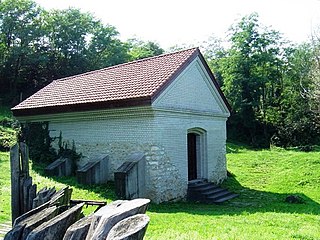
In Gallo-Roman religion, Rosmerta was a goddess of fertility and abundance, her attributes being those of plenty such as the cornucopia. Rosmerta is attested by statues and by inscriptions. In Gaul she was often depicted with the Roman god Mercury as her consort, but is sometimes found independently.
Alisanos was a local Gallo-Roman god worshipped in what is now the Côte-d'Or in Burgundy and at Aix-en-Provence.
Borvo or Bormo was an ancient Celtic god of healing springs worshipped in Gaul and Gallaecia. He was sometimes identified with the Graeco-Roman god Apollo, although his cult had preserved a high degree of autonomy during the Roman period.
Camulus or Camulos is a Celtic deity who was identified with Mars via interpretatio romana. Camulus was an important god of Roman Britain and Gaul, especially among the Belgae and the Remi, Gaulish tribes that originate from the areas of modern day Belgium, Luxembourg, Northern France and parts of Germany and the Netherlands.
In Gallo-Roman religion, Damona was a goddess worshipped in Gaul as the consort of Apollo Borvo and of Apollo Moritasgus.

In Celtic polytheism, Sirona was a goddess worshipped predominantly in East Central Gaul and along the Danubian limes. A healing deity, she was associated with healing springs; her attributes were snakes and eggs. She was sometimes depicted with Apollo Grannus or Apollo Borvo. She was particularly worshipped by the Treveri in the Moselle Valley.
In Gallo-Roman religion, Luxovios, Latinized as Luxovius, was the god of the waters of Luxeuil, worshiped in Gaul. He was a consort of Bricta. The thermal spring sanctuary at Luxeuil provided evidence of the worship of other deities, including the sky-horseman who bears a solar wheel, and Sirona, another deity associated with healing springs.

In ancient Celtic religion, Maponos or Maponus is a god of youth known mainly in northern Britain but also in Gaul. In Roman Britain, he was equated with Apollo.

In Celtic mythology, Nantosuelta is the goddess of nature, the earth, fire, and fertility.
In Romano-British culture and Germanic polytheism, the Alaisiagae were a quartet of Celtic and Germanic goddesses deifying victory.
Erditse is a god or goddess of the ancient Aquitaine Gaul, known by only one inscription which was discovered, in the 16th century, by Joseph Justus Scaliger on a votive altar found in the Parliament of Toulouse. The inscription was published in Inscriptiones totius orbis Romani antiquae by Jan Gruter. The votive altar has now disappeared. It was likely to come from the Pyrenees as many other votive altars found in the region of Comminges and dated from the 1st to the 4th century.
Ucuetis is a Gaulish deity who was venerated at Alesia in Burgundy.

Aignay-le-Duc is a commune in the eastern French department of Côte-d'Or.
Acionna was a Gallo-Roman water goddess, attested in the Orléanais region.

The Fertőrákos Mithraeum is a temple to the Roman god Mithras at Fertőrákos in Hungary. The temple, follows a typical plan of a narthex followed by the shrine proper that consists of a sunken central nave with podium benches on either side.
Artaha is the name of an ancient goddess that was worshiped in Southern Gaul, in the region of Aquitania. She is a tutelary goddess that is thought to be associated with bears.

In Gallo-Roman religion, Sequana is the goddess of the river Seine, particularly the springs at the source of the Seine. Although the origins of the goddess are Celtic, Sequana was subsequently integrated into a Gallo-Roman regional cult of worship after the Roman conquest of Gaul. The main sites dedicated to her are found in northern Burgundy, especially at the source of the Seine, where archeological excavations have unearthed a temple complex and over a thousand votive offerings.
Sexarbores is a Gallic god known only from inscriptions found in the Hautes-Pyrénées. Like the gods Abellio and Fagus, it could have been a deified tree.
The Dexivates were a small Gallic tribe dwelling in the southern part of modern Vaucluse, near the present-day village of Cadenet, during the Iron Age and the Roman period.
Rigisamus, also Rigisamos, was a deity in Gaulish and Celtic mythology who, according to the Interpretatio Romana, was connected with Mars.








